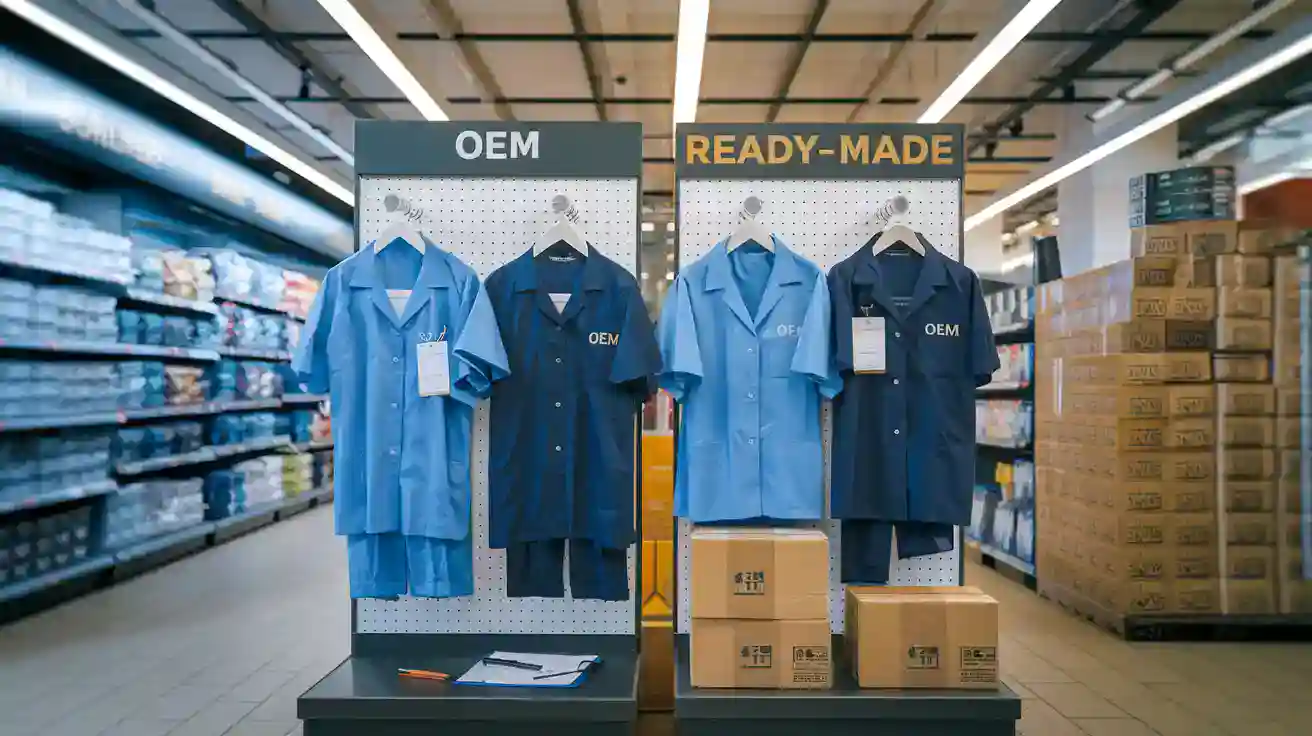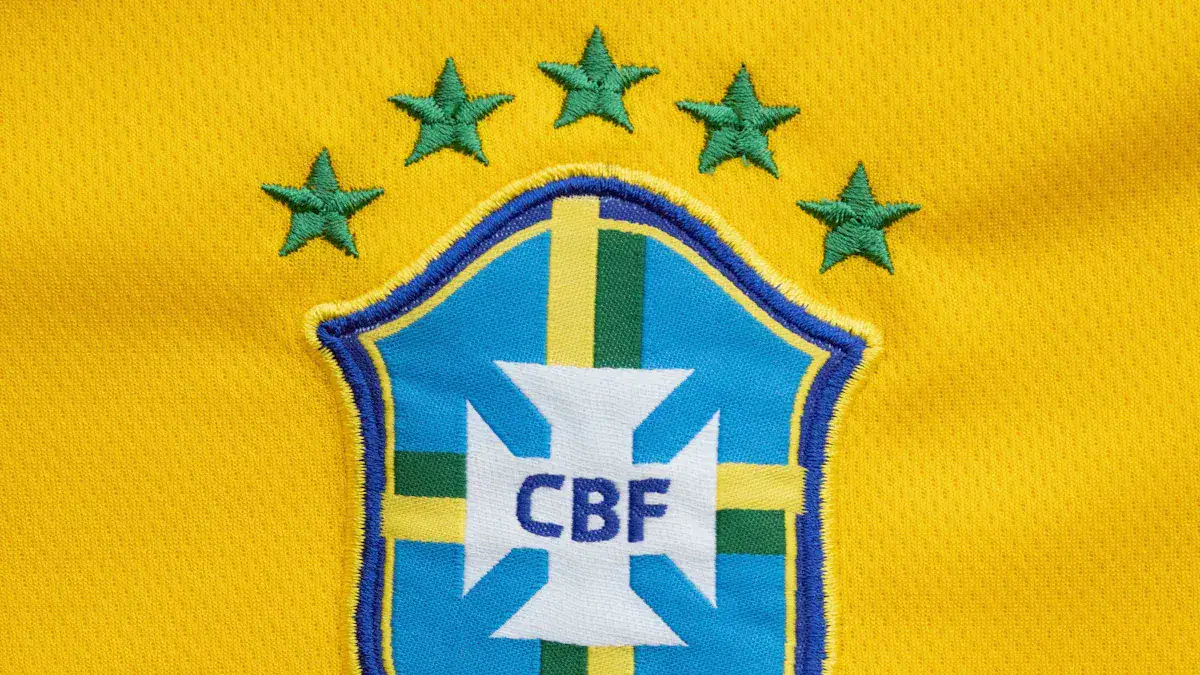Convenience Store Uniform OEM vs. Ready-Made: 5 Differences for Chain Bulk Replenishment

Choosing the right Convenience Store Uniform for your chain impacts your brand, staff efficiency, and customer experience. You want uniforms that set your team apart, create a positive impression, and support rapid staff growth. Consider these five key differences to make your decision easier:
Customization shapes brand identity.
Lead time affects hiring speed.
Cost influences your budget.
Quality impacts store image.
Replenishment flexibility supports chain expansion.
Key Takeaways
OEM uniforms offer full customization, allowing you to reflect your brand’s identity through colors, logos, and designs.
Ready-made uniforms provide immediate availability, making them ideal for quick staffing needs or tight budgets.
Investing in OEM uniforms may have higher upfront costs, but they offer long-term value through durability and brand consistency.
Quality control is stronger with OEM options, ensuring uniforms maintain their appearance and fit across all locations.
Ready-made uniforms allow for small orders, giving you flexibility to replenish uniforms without high minimums.
Consider your chain’s growth plans when choosing between OEM and ready-made uniforms to align with your budget and branding needs.
Combining both OEM and ready-made options can provide a balance of strong branding and quick replenishment.
Evaluate your priorities carefully to select the uniform strategy that best supports your chain’s success.
Branding

OEM Customization
Design Flexibility
You want your chain to stand out. OEM customization gives you full control over every detail of your Convenience Store Uniform. You choose the colors, add your logo, and select design features that reflect your brand’s personality. You can tailor uniforms to fit your staff perfectly, boosting comfort and confidence. When you invest in custom designs, you send a clear message: your brand values professionalism and consistency.
A custom uniform is often the first thing customers notice. It sets the tone for their experience. A neat, branded uniform signals that your staff is prepared and reliable. Customers trust employees who look organized and professional. When your team wears consistent workwear, your brand becomes recognizable across all locations. This consistency builds trust and makes customers feel comfortable approaching your staff.
Material Choices
OEM options let you pick materials that match your needs. You can select fabrics that are durable, easy to clean, and comfortable for long shifts. Custom uniforms often use higher quality materials, which last longer and look better over time. You avoid the hassle of frequent replacements and maintain a polished image for your chain.
Feature | Custom Uniforms | Off-the-Rack Uniforms |
|---|---|---|
Fit and Comfort | Tailored to individual measurements for comfort. | Standard sizes may not fit all employees well. |
Branding | Allows for specific logos and brand colors. | Limited branding options available. |
Design Features | Customizable features like pockets and materials. | Fixed designs with no customization. |
Durability | Higher quality materials for long-lasting use. | May not be as durable as custom options. |
Professional Appearance | Consistent look across the team. | Varies by available styles and sizes. |
Cost | Higher initial investment but better long-term value. | Lower upfront cost but may require more replacements. |
Ready-Made Options
Standard Styles
Ready-made uniforms offer convenience and speed. You get access to standard styles that are available for immediate purchase. These options work well if you need uniforms quickly or have a tight budget. However, you sacrifice the ability to customize the look and feel of your uniforms. Your staff may wear uniforms that do not fit perfectly or reflect your brand’s unique identity.
Limited Branding
With ready-made uniforms, branding options are limited. You may only add a small logo or choose from a few color choices. This lack of customization can hurt your brand consistency. Customers may not recognize your staff as easily, and your chain may blend in with competitors. If you want to build a strong brand image, ready-made uniforms may not deliver the impact you need.
Tip: If you want your chain to grow and stand out, invest in OEM customization. You create a memorable brand experience and build customer trust from the first interaction.
Lead Time
OEM Production
Approval Process
When you choose OEM production for your Convenience Store Uniform, you gain control over every detail. However, this control comes with a longer approval process. You must review and approve design samples, select materials, and confirm branding details. Each step requires your attention and sign-off. This process ensures you get exactly what you want, but it can add days or even weeks to your timeline. If your chain plans to launch a new look or open multiple locations, you need to plan ahead. Aligning your planning with design and sourcing milestones helps you respond quickly to changes in trends. This approach keeps your project on track, even when unexpected challenges arise.
Manufacturing Timeline
After you approve the final design, the manufacturing process begins. Custom uniforms require time for sourcing materials, cutting, sewing, and quality checks. Production can take several weeks, especially for large orders. Supply chain disruptions can cause further delays. You can use scenario modeling tools to prepare for these disruptions. These tools help you simulate different outcomes and adjust your sourcing strategy. Advanced planning lets you manage supplier delays and keep your delivery schedule on track. If you want a unique uniform that matches your brand, you must accept a longer lead time.
Ready-Made Speed
Immediate Availability
Ready-made uniforms offer unmatched speed. You can order standard styles and receive them almost immediately. Many suppliers keep large inventories on hand. Some manufacturers, such as A+ Career Apparel, can ship in-stock orders within eight business hours. In most cases, you can get your uniforms the same or next day. This speed gives you a huge advantage when you need to hire new staff quickly or open a new store on short notice.
Fast Shipping
Fast shipping is a major benefit of ready-made uniforms. You do not need to wait for design approvals or production. You simply select the sizes and quantities you need, place your order, and receive your shipment right away. This quick turnaround helps you avoid inventory shortages and keeps your stores running smoothly. If you face supply chain disruptions, you can use scenario modeling to adjust your orders and find alternative suppliers. This flexibility ensures you always have uniforms available for your team.
Tip: If you want to minimize downtime and respond quickly to staffing changes, choose ready-made uniforms. You get the speed and convenience your chain needs to stay competitive.
Cost
OEM Pricing
Setup Fees
When you choose OEM for your Convenience Store Uniform, you face initial setup fees. These fees cover design development, sample creation, and pattern making. You invest upfront to ensure your uniforms match your brand vision. This investment pays off if you plan to order in large quantities or want a unique look for your chain. Setup fees can seem high at first, but they help you avoid hidden costs later by locking in your design and quality standards.
Unit Cost
OEM uniforms often have a higher unit cost compared to ready-made options, especially for smaller orders. However, as your order size increases, the unit price drops. The main cost drivers include direct materials, direct labor, and manufacturing overhead. Here’s a quick breakdown:
Cost Driver | Description |
|---|---|
Direct Materials | All raw materials needed to produce the finished product. |
Direct Labor | Costs associated with workers responsible for production, such as assembly workers. |
Manufacturing Overhead | Costs not directly tied to materials or labor, including indirect labor, materials, rent, and utilities. |
You can use standardized software solutions to estimate costs and optimize your supplier selection. These tools help you make smarter decisions and keep your budget under control.
Note: OEM pricing rewards you in the long run. You get uniforms that last longer and reflect your brand, which can save you money on replacements and boost your chain’s image.
Ready-Made Pricing
Bulk Discounts
Ready-made uniforms offer strong cost advantages, especially when you buy in bulk. Many suppliers provide volume discounts, so the more you order, the less you pay per uniform. This approach helps you manage your budget and control costs as your chain grows.
Volume pricing helps you plan for expansion and seasonal hiring.
You can negotiate better deals as your order size increases.
Fixed Costs
With ready-made uniforms, you benefit from fixed wholesale pricing. This structure gives you predictable costs and makes budgeting easier. Wholesale prices often reflect the true cost of the product, not inflated retail rates. However, margins can vary by product, so you need to review your options carefully.
Fixed costs simplify your purchasing process.
You avoid unexpected price changes.
You can compare products easily and choose the best value.
Tip: If you want to control your budget and replenish uniforms quickly, ready-made options give you flexibility and cost savings.
Which Option Is More Cost-Effective?
If you want a custom look and plan to order large quantities, OEM uniforms offer better long-term value. You pay more upfront, but you get higher quality and a stronger brand presence. If you need to save money now or want to respond quickly to staffing changes, ready-made uniforms with bulk discounts and fixed costs are the smarter choice. Evaluate your chain’s needs, growth plans, and budget to make the best decision.
Quality
OEM Consistency
Material Standards
You want your staff to look sharp and feel comfortable every day. OEM suppliers let you choose high-quality fabrics that match your store’s needs. They start by selecting the best raw materials for each Convenience Store Uniform. This careful selection means your uniforms last longer and keep their color and shape, even after many washes. OEM manufacturers follow strict standards like ISO 9000, so you know every batch meets the same high level of quality.
Quality Control Measure | Description |
|---|---|
Adherence to Quality Standards | OEM manufacturers must meet standards like ISO 9000, ensuring products meet specific quality criteria. |
Quality Assurance | Every product meets standards from design to final inspection. |
Continuous Monitoring | Regular checks throughout production to maintain quality and detect deviations. |
Quality Control
You get peace of mind with OEM production because they use a multi-step quality control process. First, they check raw materials. Then, they inspect uniforms during production. Finally, they review the finished product before shipping. This process catches problems early and keeps your uniforms consistent across all stores. Leading suppliers use advanced machines and ERP systems to track every step. Certifications like ISO 9001:2015 and BSCI prove their commitment to quality. You benefit from uniforms that look the same, batch after batch, no matter how many stores you open.
Customers notice when your team looks professional. Studies show 80% of buyers find it easier to identify employees in uniforms, and 60% feel more confident in your service. High-quality uniforms boost your brand image and make your stores more inviting.
Ready-Made Variability
Stock Differences
Ready-made uniforms offer speed, but you risk inconsistency. Suppliers may change fabrics or colors without notice. One store might receive a slightly different shade or logo placement than another. This lack of control can hurt your brand’s image. Customers expect your staff to look the same at every location. If uniforms vary, your chain loses its polished, professional look.
Inconsistencies in logo and uniform appearance can dilute brand recognition.
Precision in embroidery and color matching is crucial for a polished look.
Centralized ordering helps, but stock changes can still create differences.
Consistency Risks
You face real risks with ready-made options. Variability in stock can lead to a disjointed customer experience. Customers may feel less confident if your staff looks different from store to store. Uniformity builds trust and makes your brand memorable. Without it, you blend in with competitors and lose your edge.
Requirement | Description |
|---|---|
Approved garments | Ensures all locations use the same styles and materials. |
Logo placement guidelines | Standardizes where logos appear on uniforms to maintain brand identity. |
Embroidery and screen printing | Prepares templates to avoid variations in logo application. |
Uniform quality shapes how customers see your business. A consistent, professional appearance tells customers you care about details and service. Choose wisely to protect your brand and grow your chain with confidence.
Convenience Store Uniform Replenishment

OEM Flexibility
Design Updates
You want your chain to stay fresh and relevant. OEM suppliers let you update your uniform design whenever your brand evolves. You can introduce new colors, add seasonal touches, or refresh your logo. This flexibility helps you respond to trends and customer feedback. Your stores always look modern and consistent. When you roll out a new design, every location receives the same look. This approach strengthens your brand and keeps your team feeling proud.
Minimum Orders
OEM providers often require you to meet minimum order quantities. This requirement works well if your chain is growing or you plan to open new stores. You can order in bulk and lock in your preferred design. However, if you only need a few uniforms for replacements, meeting the minimum can be a challenge. You must plan your inventory carefully. Bulk orders help you save on costs, but you need storage space and accurate forecasting.
Ready-Made Process
Small Orders
Ready-made suppliers make replenishment easy. You can order small quantities whenever you need them. This option is perfect for replacing lost or damaged uniforms or onboarding new staff quickly. You avoid the pressure of meeting high minimums. Many suppliers encourage small orders and respond fast to your requests.
Supplier | Minimum Order Quantity (MOQ) | Approach to Small Orders |
|---|---|---|
Low | Encourages email inquiries for all order sizes. |
You gain flexibility and speed. Your stores never run out of uniforms, and you keep your team looking sharp.
Stock Limits
Ready-made uniforms come with some risks. Suppliers may run out of your preferred style or size. Stock changes can happen without warning. If you rely on a specific look, you might face inconsistencies across your locations. You need to monitor supplier inventory and act fast when you see low stock. This approach works best if you value speed over strict uniformity.
Tip: Combine both options for the best results. Use OEM for your core design and ready-made for quick replacements. This hybrid strategy gives you strong branding and fast replenishment.
The choice between OEM and ready-made uniforms shapes your inventory management. Ready-made options help you control costs and respond to urgent needs. OEM uniforms give you unique branding and consistency, which supports long-term growth. Many successful chains use a mix of both. You get the speed and savings of ready-made, plus the brand power of custom designs. Choose the approach that matches your chain’s goals and growth plans.
Choosing between OEM and ready-made uniforms shapes your brand, budget, and growth. Use this table to guide your decision:
OEM Uniforms | Ready-Made Uniforms | |
|---|---|---|
Customization | High | Low |
Lead Time | Longer | Immediate |
Cost | Higher upfront, long-term value | Lower, quick replenishment |
Quality | Consistent, controlled | Variable, stock-dependent |
Replenishment | Bulk, planned | Flexible, small orders |
Review your order trends and volume.
Prioritize branding for large chains.
Choose speed and flexibility for rapid hiring.
Assess your priorities. The right uniform strategy will boost your chain’s success.
FAQ
What is the main benefit of choosing OEM uniforms for my chain?
You get full control over design, fit, and materials. This ensures your brand stands out and your staff looks professional. Strong branding builds customer trust and loyalty.
How fast can I receive ready-made uniforms for new hires?
You can receive ready-made uniforms almost immediately. Most suppliers ship in-stock items within one or two days. This speed helps you onboard staff quickly and avoid delays.
Are OEM uniforms more expensive than ready-made options?
You pay more upfront for OEM uniforms. However, you gain long-term value through better quality and durability. You save money on replacements and strengthen your brand image.
Can I order small quantities of OEM uniforms for replacements?
Most OEM suppliers require minimum order quantities. If you need only a few replacements, ready-made uniforms offer more flexibility and faster delivery.
Will ready-made uniforms match my brand colors and logo exactly?
Ready-made uniforms offer limited customization. You may not get an exact color match or precise logo placement. For perfect brand consistency, choose OEM uniforms.
How do I decide which uniform option fits my chain best?
Review your priorities. If you want strong branding and long-term value, choose OEM. If you need speed and flexibility, go with ready-made. Many successful chains use both for the best results.
Can I update my uniform design easily with OEM suppliers?
Yes, you can refresh your design, add new features, or update your logo with OEM suppliers. This keeps your chain looking modern and relevant.
What if my supplier runs out of ready-made uniforms?
You risk inconsistencies if stock runs out. Monitor inventory closely and act fast. For critical branding, keep a backup plan with OEM or hybrid options.

